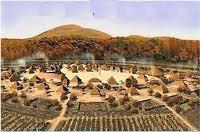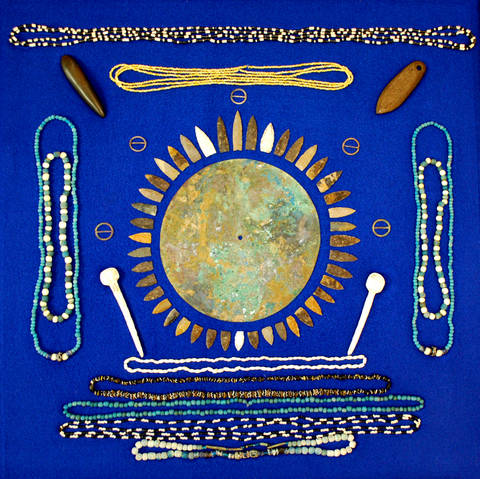
The Hitchiti were a Muskogean-speaking tribe formerly residing chiefly in a town of the same name on the east bank of the Chattahoochee River, 4 miles below Chiaha, in west Georgia. They spoke the Hitchiti language, which was mutually intelligible with Mikasuki; both tribes were part of the loose Creek confederacy. The latter language is still spoken by the Miccsukee tribe of Florida, as well as many Seminole.
When the US Indian agent Benjamin Hawkins visited the Hitchiti in 1799, he recorded that they had spread out into two branch settlements. The Hitchitudshi, or Little Hitchiti, lived on both sides of Flint River below the junction of Kinchafoonee Creek, which passes through a county once named after it. The Tutalosi lived on a branch of Kinchafoonee Creek, 20 miles west of Hitchitudshi.

A collection of Hitchiti artifacts found in one location at a Hitchiti town. The collection includes a large copper disc at the center surrounded by Guntersville points, a variety of trade beads that indicate a heavy involvement in fur trade with the English, two ear plugs, 5 worked silver circles typical of the silver work of their decedents the Seminoles, a stone pendent (upper right), and a highly polished flaking tool (upper left). These are all now part of the Bruce Butts collection.
The tribe is not often mentioned in historical records. It was first recorded in 1733, when two of its delegates were noted as accompanying the Lower Creek chiefs to meet Governor James Oglethorpe at Savannah.
The language appears to have been used beyond the territorial limits of the tribe: it was spoken in the towns on the Chattahoochee, such as Chiaha, Chiahudshi, Hitchiti, Oconee, Sawokli, Sawokliudshi, and Apalachicola, and in those on Flint River, and also by the Miccsukee tribe of Florida. Traceable by local names in Hitchiti, the language appeared over considerable portions of Georgia and Florida. Like Creek, this language has an archaic form called “woman’s talk,” or female language.
Scholars believe that the Yamasee also spoke Hitchiti, but the evidence is not conclusive. Other evidence pointed toward their speaking a different language, perhaps one related to Guale.
The Hitchiti were absorbed into and became an integral part of the Creek Nation, though preserving to a large extent their own language and customs. Similarly, those Mikasuki-speakers who joined the Lower Creek migrations to Florida maintained their culture. For years after being included among the Seminole, which formed from remnant peoples in Florida, in 1962 they gained federal recognition as the Miccsukee Tribe of Indians in Florida.